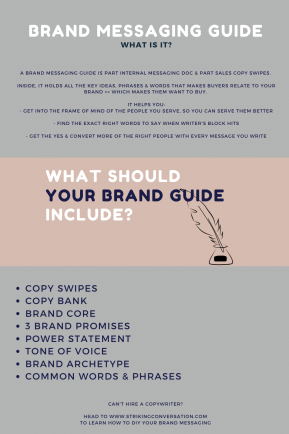You know that old saying, “give a man a fish and he’ll eat for a day; teach a man to fish and he’ll eat for a lifetime”?
My version of that includes teaching you how to DIY your copy so that you feel more confident, have greater impact and can spend less time on your marketing words.
Because the truth is, you’re not going to be able to hire a professional for every word you write for your business – you’ve gotta know how to DIY!
And it all starts with a stellar brand messaging strategy.
Today, I’m dishing the exact steps I take to help businesses like yours develop clear, impactful messaging for your brand so that you can write better words, faster.
Let’s dive in!

What is a brand messaging strategy?
Me: *sends new client on-boarding questionnaire*
Question: “Do you have a brand messaging guide?”
Client: “LOL – no, what is that?”
“Brand messaging strategy” *sounds* big-corp level fancy – but really, it’s just a document designed to help you tie together every piece of content you create in your business.
Think of it like a mood board for your words – it’s sole purpose is to guide the language you use in every piece of content you create.
It’s part internal messaging doc and part sales copy swipes.
Inside, it holds all the key ideas, phrases and words that makes buyers relate to your brand voice and connect with your copywriting… which makes them want to buy.
It helps you:
- get into the frame of mind of the people you serve, so you can serve them better
- find the exact right words to say when writer’s block hits
- get the yes and convert more of the right people with every message you write

Basically? A brand messaging guide is *the* reference point for everything you create for your business.
Why is a brand messaging guide important?
It’s SO important to have one, even if you’re currently the only person on your team.
It’s true, nobody knows your offers (or your audience) quite as well as you do – but when push comes to shove, you can only store so much information in that entrepreneurial brain of yours.
Keeping a detailed messaging guide on hand gets all that information out on paper, freeing up brain space and making it a lot easier to develop and organize your content strategy, brand voice and copywriting.
Plus, putting together a solid messaging guide NOW, will make it so much easier to on-board a new team member or freelancer when the time comes.
It’s basically like giving a high-five to your future self.

Essential elements you need in your brand messaging guide
Your messaging guide should be a living, breathing document that expands and contracts as your business changes.
That being said, there are 6 *key* elements every messaging guide should have fleshed out.
6 Key Elements Every Brand Messaging Guide Needs
Copy Swipes
These are comment snippets straight from the mouth of your ideal customer. These come from reviews, surveys, social media comments, etc. Include anything that expresses a desire or need that you are able to fill or problem you have solved.
Example: recently a client told me she felt like I waved a magic wand over her copy and made it more effective. If I wanted to run with that, I could open my services page by saying something like “Wishing you hand a magic wand for your sales copy?”
As Scott Cook said, “A brand is no longer what we tell the consumer it is – it is what consumers tell each other it is.”
When you keep track of dream customers’ needs and echo back to them what they are likely already thinking to themselves, they are more likely to be on board.
Copy Bank
Simply put – a copy bank is a list of on-brand, high-impact words and phrases that describe the problem you solve and how.
Start by jotting down words you see repeated over and over by your dream customers in your copy swipe research. What do your ideal clients want most out of working with you? What patterns do you see in their choice of language? Do they use big, complicated words or short, simple ones? (I like to use the Hemingway App to analyze all those little details!)
To enhance your list and help your message stand out above the noise, use a thesaurus to replace some of the more generic words with words that communicate the same thing in a more powerful way.
Example: Authenticity -> Transparency
Freedom -> Breathing room
Brand Core
This is the central idea of every piece of content or offering filters through. Every time you sit down to create a marketing plan, freebie, or new offering come back to your core statement to focus your message and keep everything consistent with your brand voice and copywriting.
Your core should center around your ideal customer’s goals and desires + how you can help them reach them.
Example: you are a personal finance coach that teaches people how to be financially independent through non-restrictive budgeting.
Your core: Values oriented budget coaching that empowers you to live life on your own terms
^ now every time you sit down to create something in your business, ask “How does this empower people to use their finances to live out their values?” Anything that doesn’t answer that question, shouldn’t be something you spend your time on.
3 Brand Promises
The “Power of Three” works so well throughout any form of communication because it’s the smallest number of elements required for the human brain to notice a pattern. Essentially, it’s proven to be the most effective way to communicate when you want someone to understand and remember what you’re trying to say. And this simplicity and clarity = marketing gold. Because out of everything you’ll write for your brand, your 3 brand promises are the pillars which every other piece of copy expands upon.
Sticking with the example of the financial coach above, your 3 promises might be:
Take back the reins
Safe-guard your future
Live life abundantly
Use your copy swipes and bank to play around with different words, angles and combinations that perfectly represent who you are, what you do and how you help your ideal customers.
Power Statement
This is simply a 15 – 30 word statement that expands upon your brand core and power statement. Your power statement should explain who your business is for, the pain points your business helps solve and the outcome or promises to the customer.
Example: Be empowered to take back your financial reins, safe-guard your future and live more abundantly with 1-on-1 budget planning designed to align with who you are at your core.
Tone of Voice: This is the perspective you use to approach your writing, educating and work from.
Are you serious? Energetic? Cheeky? Progressive? Firey? Do you use big, complicated words or short, simple words? How does your tone of voice fit with your customer’s voice from your copy bank?
Nailing your tone of voice helps to make sure that when you show up, you are showing up and serving in a way that feels the most natural to you.
Tips to creating a useful messaging guide
Tip #1: Know your brand archetype
If you’ve never heard of the 12 brand archetypes, they are basically personalities or situations that are easily recognizable and stand the test of time.
I won’t dive into all the archetypes here (there are a ton of resources and information on them online. My friend and client, Kaye Putnam, has a great quiz and stellar resources if you want to learn more.) – but if you are struggling to create messaging that is consistent and effective, I highly recommend figuring out your top two archetypes BEFORE you start creating your messaging guide.
Tip #2: “Pantry Cook” your words
Some of my best dinners came about from just opening up my pantry and cooking up whatever I found floating around in there.
The point? If you’ve been in business any length of time, you *probably* already have a few words and phrases on hand that you like to pull out when the time is right. Just because you’ve never put together a brand messaging guide before doesn’t mean you don’t already have the elements shitting in your digital pantry, waiting to be put together.
Go back into your archives and pull out your tried and true words. Play with combinations, pair them with new words from your copy bank, sub them in for words from your copy swipes – really figure out the best way to leverage what you already have.
Your brand voice and copywriting (and conversions!) will be better for it!
Creating all this can be a bit overwhelming (and maybe even feel a tad bit like busy work at first) – but I promise, if you take the time to get *really* clear on your brand words, you will save so much time when you sit down to write for your business.
Try HoneyBook’s client management software for small businesses to help you even further on your business journey.
Ready to connect and convert your ideal clients? Get our Brand Voice & Copywriting Ultimate Guide.
Plus, 5 more posts you might like:


